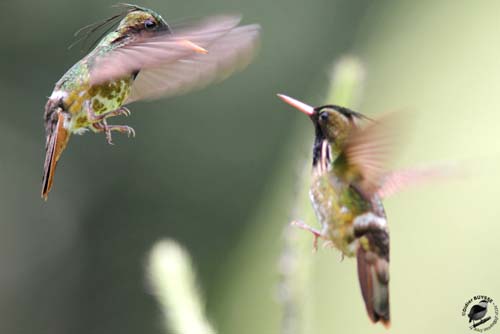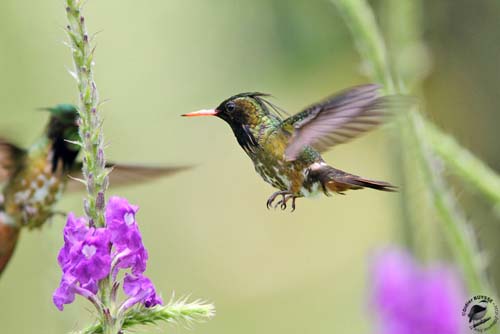
PROTECTION / THREATS / STATUTS:
The Black-crested Coquette is uncommon, but the species is not threatened at this moment.
This species frequents man-made habitats such as plantations, and the numbers of mature birds are relatively stable, in spite of some declines (about 10%) in the last ten years.
Fr: Coquette d’Hélène
All : Schwarzschopfelfe
Esp: Coqueta Crestinegra
Ital: Colibrì coquette crestanera
Nd: Zwartkuif-koketkolibrie
Photographer :
Didier Buysse
Vision d’Oiseaux
Text by Nicole Bouglouan
Sources :
HANDBOOK OF THE BIRDS OF THE WORLD Vol 5 by Josep del Hoyo-Andrew Elliott-Jordi Sargatal - Lynx Edicions - ISBN: 8487334253
A GUIDE TO THE BIRDS OF MEXICO AND NORTHERN CENTRAL AMERICA by Steve N. G. Howell, Sophie Webb - Oxford University Press - ISBN: 0198540124
L’ENCYCLOPEDIE MONDIALE DES OISEAUX - Dr Christopher M. Perrins - BORDAS - ISBN: 2040185607
BirdLife International (BirdLife International)
Black-crested Coquette
Lophornis helenae
Apodiforme Order – Trochilidae Family
BIOMETRICS:
Length: 6,5-7 cm
Weight: 2,6-2,8 g
DESCRIPTION:
All members of genus Lophornis have a conspicuous crest often raised during the displays.
The hummingbirds named “coquette” are among the tiniest birds.
The Black-crested Coquette adult male has bronze-green upperparts and white band across the rump, whereas the uppertail coverts are black. Wings are dark olive-green. Tail is slightly forked, with dark green central rectrices and other tail feathers are rufous with dusky green edges.
On the underparts, the throat is glossy green and the breast is black, bordered by bronze breast band. Belly is white and shows conspicuous iridescent golden-bronze rounded spots. Vent is white. Undertail coverts are rufous.

On the head, the crown is iridescent green and shows a wispy crest made with some elongated dark feathers. Face is darker, rather glossy blackish-green according to the lighting. We can see some other elongated lateral feathers on the throat sides. These feathers are black, with pale buff inner web.
The thin, straight bill is red with black tip. Eyes are dark brown. Short legs and feet are pinkish-grey. Feet are reduced because the hummingbirds do not use them for hopping, walking or climbing as numerous other birds’ species do. This criterion is common to all hummingbirds which spend most of the day hovering. Such flight requires a lot of energy.
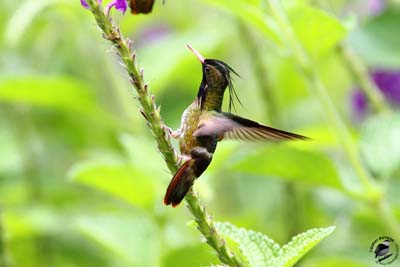
Female has whitish throat flecked dark. She has shorter crest, and the feathers of the throat sides are absent. Tail is rounded. Bill is blackish on the upper mandible.
Immature male resembles female and shows vestige of crest. Throat is whitish and upper breast is blackish.
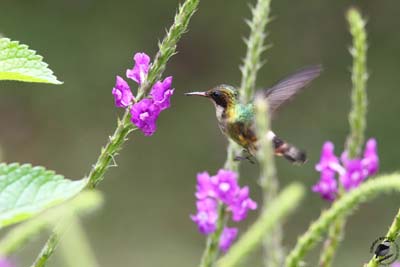
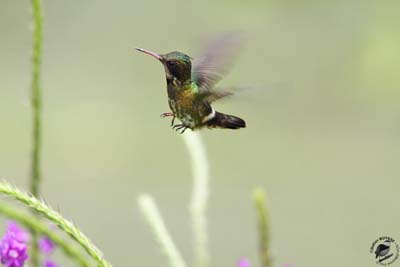
VOICE: SOUNDS BY XENO-CANTO
The Black-crested Coquette, as other Trochilid species, utters high-pitched, short calls. These unmelodious sounds are heard when the birds are feeding “teek”, or as advertising calls when they defend a rich food source.
But usually, singing activity is closely associated to breeding season during which they utter a repeated upslurred “tsuwee”, and also to defence behaviour. When fighting, they give a high-pitched twittering.
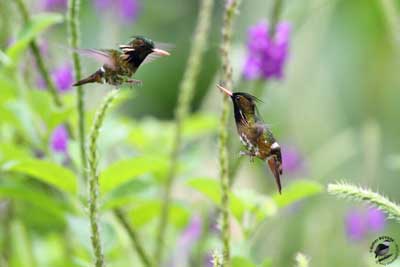
HABITAT:
The Black-crested Coquette frequents semi-open habitats. It also can be seen at forest edges, in second growth and plantations.
This species occurs between 100 and 1200 metres of elevation.
RANGE:
The Black-crested Coquette is found in S Mexico and S to E Costa Rica, but also in Belize, Guatemala, Honduras and Nicaragua.
BEHAVIOUR:
The Black-crested Coquette usually forages at canopy level.
It feeds on nectar from flowers of several plant species. It also gleans arthropods from the vegetation, foliage and tiny branches.
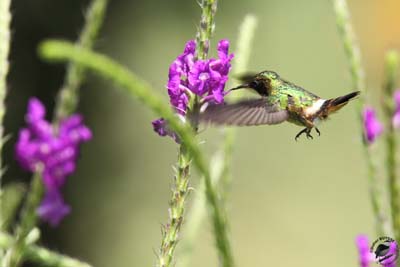
IMMATURE MALE
OR ADULT FEMALE
This species feeds by “trap-lining” technique, as several species do according to the bill-shape. The members of genus Lophornis take advantage of their very small size, resembling large insects, and do not hesitate to feed in areas within a territory which is not directly visible or guarded by the owner.
They forage in trap-line, following a repeated foraging circuit.
The Black-crested Coquette is sedentary in its range. Some irregular seasonal altitudinal movements can be observed.
As other hummingbirds from small to large species, the Black-crested Coquette defends its feeding territory against intruders.
Even if many species are trap-line feeders on nectar sources too scattered to be defended, and do not establish true feeding territories, some intimidation behaviour occurs if two birds feed in close vicinity. They are mainly non-territorial but with limits, according to the situation.
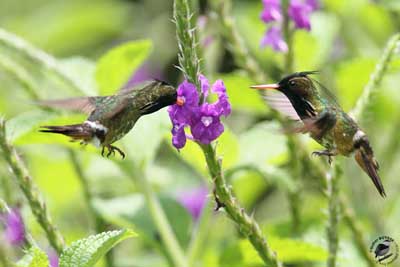
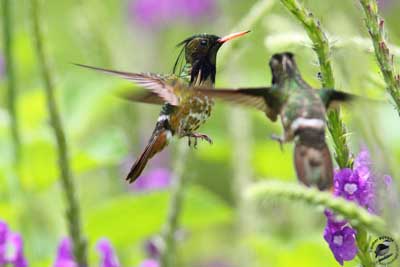
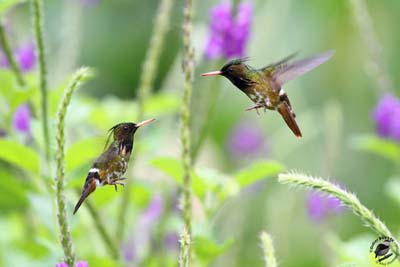
FLIGHT:
The Black-crested Coquette performs active hovering to feed on nectar from flowers. It is able to fly forwards and backwards, and the wings draw flattened “8”. Such active flight requires energy, and according to the temperature, the frequency of wing-beats changes, involving energy conservation.
REPRODUCTION:
The nesting behaviour of the Black-crested Coquette is poorly known.
Nest has been found in March, placed at the end of a twig, at about 8 metres above the ground.
The tiny nest is cup-shaped and made with fine plant materials. The nest-site is probably near the feeding areas.
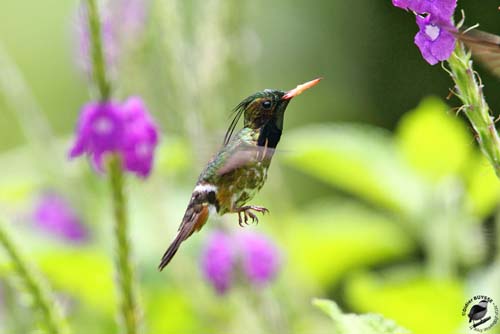
During the courtship displays, the male expose its glossy plumage. The crest is also displayed, as the elongated feathers of the throat sides. Displays are accompanied by vocalizations. The white rump is probably exposed too, the male raising the back feathers to show off the white area. Males are usually polygamous.
DIET:
The Black-crested Coquette feeds on nectar from several flowers such as Clusia, Cordia, Dipterix, Hampea and others. It also consumes arthropods gleaned from foliage and twigs.
